|
|
 |
|
|
3. Fallschirmjagerdivision
3. Fallschirmjägerdivision
“You know those Germans are the best soldiers I ever saw. They’re smart and they don’t know what the word ‘fear’ means. They come in and they keep coming until they get their job done or you kill them… If they had as many people as we have they could come right through us any time they made up their minds to do it.”
Battalion CO 116th Infantry Regiment on
3. Fallschirmjägerdivision
The 3. Fallschirmjägerdivision is a newly raised unit, having been established on 5 November 1943. At its core was the original 6. Fallschirmjägerregiment, which after fighting in Italy was transferred from 2. Fallschirmjägerdivision to 3. Fallschirmjägerdivision, where it was split into various cadres. The new division was scheduled to be fully organised and trained by February 1944.
|
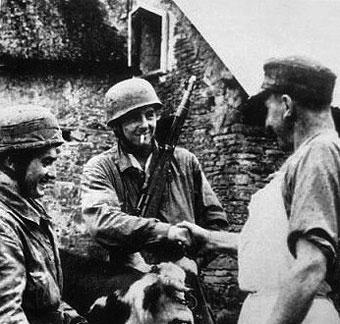 |
|
It was to be based in Reims100 miles to the east of Paris, but it was decided to set up the division in Monts d’ Arree, in west Brittany where, as the divisional commander Generalleutnant Richard Schimpf stated, “…there were no unwholesome diversionary influences in the line of amusements, such as were usually found in France.”
Despite the fact that no large-scale German airborne operations had taken place since Crete in 1941, almost 90 per cent of the 3. Fallschirmjägerdivision had completed their jump training before D-Day. By 1 March 1944 the division had 15,075 men and 12 weeks later had a ration strength of 17,420. Nominally, the unit was to be motorised, but by June it still had no more than 40% of its authorised motor transport, even after commandeering local vehicles. This was to have an impact when trying to move the division towards the invasion front.
The 3. Fallschirmjägerdivision was made of the 5., 8. and 9. Fallschirmjägerregiment’s as well as an artillery regiment (of just one battalion), engineer and anti-tank battalions and a Flak battalion (actually 2. Fallschirmjägerdivision’s Flak battalion). The division was arranged as follows:
|
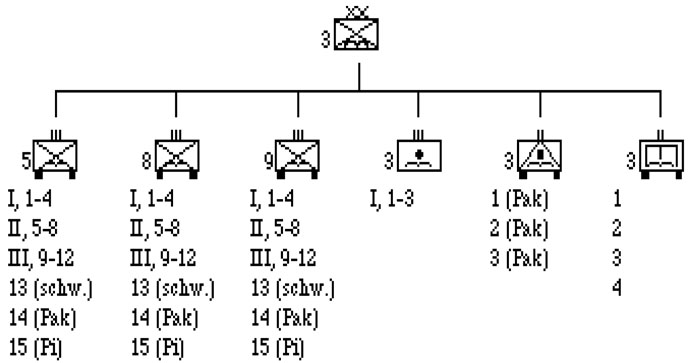 |
The paratrooper regiments were lavishly equipped with automatic weapons, with the division having 930 light machines guns, which is 11 times as many as the American 29th Infantry Division it would be fighting soon near St. Lo. It also possessed 2 ½ times as many 8cm mortars as an equivalent American division.
The personnel of the division on 6 June 1944 were as follows:
3. Fallschirmjägerdivision
Commander – Generalleutnant Richard Schimpf
Chief of Staff – Major Lutz Wagner
5. Fallschirmjägerregiment
Commander – Major Karl-Heinz Becker
I. Bataillion – Hauptmann Adolf Specht
II. Bataillion – Hauptmann Walter Münter
III. Bataillion – Hauptmann Eberhard Boerger
8. Fallschirmjägerregiment
Commander – Oberstleutnant Egon Liebach
I. Bataillion – Major Oskar Wiedermann
II. Bataillion – Hauptmann Karl Voshage
III. Bataillion – Hauptmann Josef Krammling
9. Fallschirmjägerregiment
Commander – Major Stephani
I. Bataillion
Commander – Major Friedrich Alpers
1.Kompanie (Rifle) - Leutnant Waitschader
2. Kompanie (Rifle) - Hauptmann Lepzig
3. Kompanie (Rifle)
4. Kompanie (Heavy)
II. Bataillion
Commander – Hauptmann Kurt Ladwig
5. Kompanie (Rifle)
6. Kompanie (Rifle) - Hauptmann Ladwig
7. Kompanie (Rifle) - Oberleutnant Axel von de Camp
8. Kompanie (Heavy)
III. Bataillion
Commander – Hauptmann Karl Meyer
9. Kompanie (Rifle)
10. Kompanie (Rifle) - Leutnant Forscher
11. Kompanie (Rifle) – Hauptmann Matula
12. Kompanie (Heavy)
13. Schwere GrW.Kompanie (Heavy Mortar) - Leutnant Josef Glaser
14. Panzerjägerkompanie (Anti-tank)
15. Pionerekompanie (Engineer)
3. Fallschirmjäger-Artillerie-Abteilung
Commander – Major Hans-Eberhard von Bauer
3. Fallschirmjäger-Panzerjäger-Abteilung
Commander – Hauptmann Persch
3. Fallschirmjäger-Pionere-Batallion
Commander – Hauptmann Karl Beth
3. Fallschirmjäger-Flak-Abteilung
Commander – Oberleutnant Freidrich
3. Fallschirmjäger-Nachrichten-Abteilung
Commander – Hauptmann Hölzner |
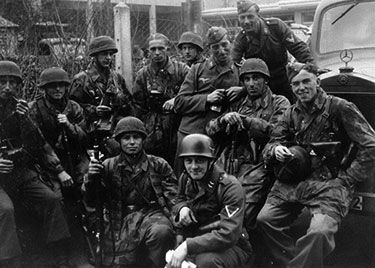 |
On the morning of D-Day, 7. Armee assigned the clean up of a suspected parachute landing on the west coast of the Cotentin Peninsula to the II. Fallschirm-Korps of which 3. Fallschirmjägerdivision was the principal unit. The division’s vehicles were pooled and an advance party, Kampfgruppe Alpers, was formed. It consisted on one battalion from each of the parachute regiments, two engineer companies, two artillery batteries, and anti-aircraft and signals battalions.
Soon it was determined that the reports of airborne landings near the west coast were false and the motorised group was ordered to move to the sector between Carentan and St. Lo to shore up the 352. Infanteriedivision. The advance party made good time, travelling mainly at night along secondary roads and reached the assembly area at Brecy-Villedieu, behind the front lines, on 10 June without being interdicted from the air.
|
|
The trucks, once unloaded, turned around and headed back to the division, which was by now marching towards Normandy, to pick up the next load. By 12 June the main combat elements of the division had assembled near St. Lô with the remainder of the force having arrived by 22 June 1944.
HILL 192
The division was quickly in action on 12 June, and over the next two days it halted the advance of the US 2nd (Indian Head) Infantry Division who were attempting to capture Hill 192, a height that dominated the eastern approaches to the strategic town of St. Lô. The Fallschirmjäger were again attacked on 16 June by all three of 2nd Division’s infantry regiments. One US battalion drove halfway up the bocage-covered slope of Hill 192, but were unable to dig out the Jäger and had to be withdrawn.
|
| The Americans determined that any attempt to take St. Lô would have to successfully deal with the hill as it gave the German artillery observers a view from Caumont in the east to the invasion beaches in the north. From the 17 June to 10 July 1944, despite the Fallschirmjäger positions on Hill 192 remaining a thorn in the side of the US First Army’s Caumont salient, the Americans did not attack. They contented themselves with shelling the area until as one observer recalled it was, “…so pounded by artillery that aerial photographs showed it as a moth-eaten white blanket.” Meanwhile the US 2nd Infantry Division digested the lessons they had learnt in hedgerow fighting and developed new tactics. |
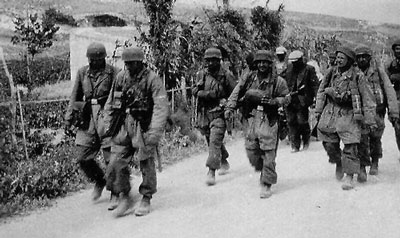 |
|
The defending Jäger used the intricate pattern of bocage fields and orchards dissecting the hill to set up mutually supporting strongpoints, digging into the hedgerows and tunnelling to provide safety and living quarters to several men. The men, from 5. and 9. Fallschirmjägerregiment’s also had plenty of time to protect tactically important areas with machine-guns, mortars and anti-tank guns.
The new attack was launched on 11 July 1944, with the 38th Infantry Regiment tasked to capture the summit of Hill 192. It was supported by 741st Tank battalion, a company of engineers and a company from the 81st Chemical Mortar Battalion. The other US regiment involved in the attack, the 23rd were to fight across the eastern slope of the hill and to reach the St. Lô – Bayeux highway beyond. These two units would be supported by direct fire from 9th Infantry Regiment, and by indirect fire from the 2nd Divisions own guns as well as two additional battalions of artillery from the 1st Infantry Division, the guns from one combat command of the 2nd Armoured Division and the 62nd Armoured Field Artillery Battalion. A massive air strike was also proposed, but this had to be called off at the last minute due to bad weather.
|
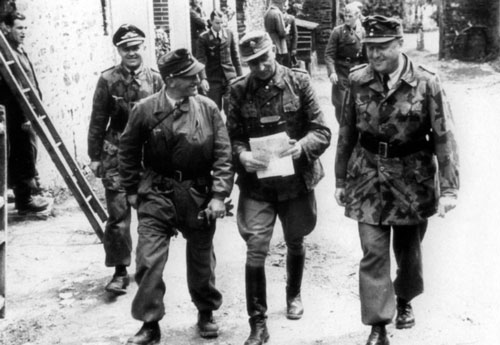 |
The 38th Regiment’s advance immediately ran into stiff opposition from a half company of the III. Bataillion, 9. Fallschirmjägerregiment who were defending a set of strongpoints known as “Kraut Corner” near Cloville with automatic weapons and mortar fire. It took over an hour to silence the defenders of Kraut Corner, which had to be outflanked, while three paratroopers who refused to surrender were buried by a tank dozer.
The battle developed into a brutal field-by-field combat broken up with house-to-house fighting in the villages of Cloville and le Soulaire, interspersed with brief tank duels between the American’s Shermans, the German Panzer IVs and Fallschirmjäger StuGs.
|
|
In the centre of the battlefield, Jäger had crept forward from their foxholes despite the heavy artillery barrage and forced the Americans to fight just to reach their line of departure, knocking out or forcing to withdraw all 6 tanks supporting the US infantry.
The US 23rd Infantry Regiment’s 1st Battalion faced a piece of ground so well covered by the Fallschirmjäger that it was known as “Purple Heart Draw”. The German paratroopers waited until the Ami’s reached the bottom of the draw before opening fire, ambushing them with mortar, artillery and automatic weapons causing serious casualties. By the end of the day the majority of the defending Fallschirmjäger had been forced to withdraw from Hill 192 to the next set of ridges beyond the St. Lô – Bayeux highway, covering the road with panzerschreck, panzerfaust and anti-tank gun fire, stopping any American tanks from crossing. Part of Purple Heart Draw was still in German hands, but this was just a small salient.
|
|
The US advances ranged from the 38th Infantry’s average of 900 yards on an 800-yard front, with one battalion reaching their objective, to units of the 23rd Infantry making 1500 yards and still falling 400 yards short. One American company was involved in such hard fighting throughout the day that its gain was just one hedgerow.
The next day the American artillery delivered the following leaflet to the men of 5. Fallschirmjägerregiment:
|
|
Soldiers of Fallschirmjäger-regiment 5!
Hill 192
Hill 192 is your left flank.
Hill 192 is a strong point held by your comrades from Fallschirmjäger 9.
Hill 192 is ours since last night. The men of Fallschirmjäger-regiment 9 remained in their positions. But even the best of soldiers were no match for the superiority of our artillery and the deadly fire of our mortars. The foxholes you have taken so much trouble to dig will only give you limited protection.
You will lose all your comrades when we attack.
Fallschirmjäger-regiment 9 is about to be wiped out.
The best thing you can do is surrender.
Have you talked among yourselves about the Panzers that have fallen back? Like your artillery? Do you think that the trucks will risk coming up to supply you?
Young men from your regiment have already talked about this; they’re asking you to join them. To cease resistance is not cowardice but just human common sense. Fighting against such superior forces is not a question of courage but rather of suicide, and for a lost cause.
This is what 142 men from your regiment have understood.
This is a victory for the prisoners who are behind American lines.
If you want to stay alive,
If you want to go home,
Take this advice:
STOP EVERYTHING
|
Other leaflets also tried to entice the Jäger to surrender, however, as there was no longer any toilet paper coming up to the front lines, these tracts provided a handy alternative.
ST. LÔ
Closer to St. Lô other companies of the 3. Fallschirmjägerdivision faced off against the US 29th (Blue and Grey) Infantry Division and the 747th Tank Battalion who attacked towards the city on the right flank of the 2nd Infantry Division. Perhaps aware that a major assault was just about to be launched, at 0130hrs on 11 July men from the I. Bataillion 9. Fallschirmjägerregiment began a surprise attack against the 1st Battalion, 115th Infantry Regiment, whose commander Major Glover S. Johns later described as being |
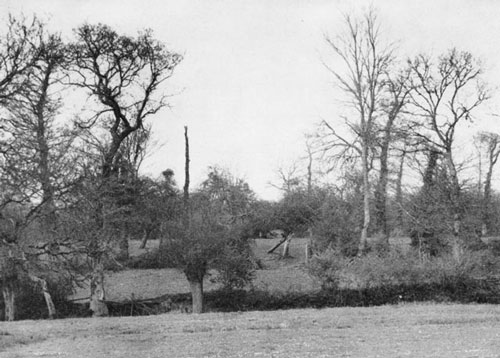 |
| “…beautifully executed and planned.” A Jäger patrol was first sent out to cut every phone line they came across, disrupting communications. Then a large artillery and mortar barrage struck the American, before rolling through their lines, with the German paratroopers close behind. Surprise was almost complete and the forward outposts were quickly overrun. The Jäger hit the gap between two companies and overran the command post of A Company. A desperate and wild melee ensued with no real control on either side. Fallschirmjäger engaged the mortar platoons in the American rear areas and drove them back, while the veteran US infantry units tried to hold their ground, stay in their foxholes and shoot anything that moved. |
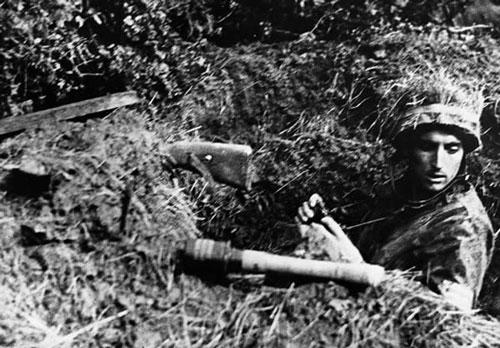 |
The attack was over as quickly as it had begun and accomplished little apart from throwing the 115th’s assault scheduled for 0600 hour to midday. Forewarned of the coming attack the Fallschirmjäger again inflicted heavy casualties on the American unit so that by the end of the day 1st Battalion, 115th Infantry Regiment had lost one-third of its strength. The 29th Division’s commander told his Corps Commander, “The stuff ahead is pretty stout.” Over the next three days 3. Fallschirmjägerdivision continued to put up stout resistance, causing high losses of little gains and ending any hope the Americans had of quickly taking St. Lô.
|
|
The American tried to move forward, while the Germans desperately hung on, and when the opportunity arose, counterattacked. When available, these counterattacks were supported by tanks and self-propelled guns.
An American officer gives this excellent account of the hedgerow fighting that took place near St. Lô between the Jäger and the Ami:
There were just three ways that our infantry could get through the hedgerow country. They could walk down the road, which always makes the leading men feel practically naked (and they are). They could attempt to get through gaps in the corners of the hedgerows and crawl up along the row leading forward or rush through in a group and spread out in the field beyond. This was not a popular method. In the first place often there were no gaps just when yon wanted one most, and in the second place the Germans knew about them before we did and were usually prepared with machine-gun and machine-pistol reception committees. The third method was to rush a skirmish line over a hedgerow and then across the field. This could have been a fair method if there had been no hedgerows.
Usually we could not get through the hedge without hacking a way through. This of course took time, and a German machine gun can fire a lot of rounds in a very short time. Sometimes the hedges themselves were not thick. But it still took time for the infantryman to climb up the bank and scramble over, during which time he was a luscious target, and when he got over the Germans knew exactly where he was. All in all it was very discouraging to the men who had to go first. The farther to the rear one got the easier it all seemed.
Of course the Germans did not defend every hedgerow, but no one knew without stepping out into the spotlight which ones he did defend.
It was difficult to gain fire superiority when it was most needed. In the first place machine guns were almost useless in the attack because about the only way they could be used was to fire from the hip. If you set them up before the advance started, they had no field of fire and could not shoot the enemy. If you carried them along until you met the enemy, still the only way to get them in position was to set them up on top of a hedgerow bank. That was not good because the German was in the next bank and got you before you set the gun down. Anyway, it had to be laid on the bank, no tripod, just a gun barrel lying unevenly on its stomach. On the other hand the Germans could dig their guns into the banks in advance, camouflage them, and be all set to cover the roads, trails, and other bottlenecks our men had to use.
|
| The artillery was the major fire support weapon. But it suffered certain handicaps. In the first place it had to be adjusted from the front line by forward observers. These sometimes had difficulty knowing just where they were, and the trees frequently delayed adjustment because of the short vision. If you found the enemy in the next hedgerow he was frequently less than 100 yards from you, and that was too close for artillery fire, particularly since short rounds would probably burst in the trees over your men in your own hedgerow. |
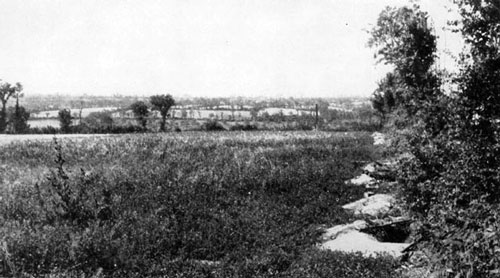 |
|
If the enemy was two or more hedgerows ahead of you, that wasn't so good either, because the mere delay in getting to him through that last hedgerow just in front of him gave him time to rise up and smite you after the artillery lifted. The mortars were effective providing you knew just what to shoot at and where it was, but the infantryman still had the delay and exposure of getting through the last hedgerow.
The Germans, being on the defensive, profited by these minor items of the terrain. They could dig in, site their weapons to cover the approaches, and prepare tunnels and other covered exits for themselves. Then when our men appeared, laboriously working their way forward, the Germans could knock off the first one or two, cause the others to duck down behind the bank, and then call for his own mortar support. The German mortars were very, very efficient. By the time our men were ready to go after him, the German and his men and guns had obligingly retired to the next stop. If our men had rushed him instead of ducking down behind the bank, his machine gun or machine pistol would knock a number off. For our infantrymen, it was what you might call in baseball parlance, a fielder's choice. No man was very enthusiastic about it. But back in the dugout I have often heard the remark in tones of contempt and anger: "Why don't they get up and go?"
|
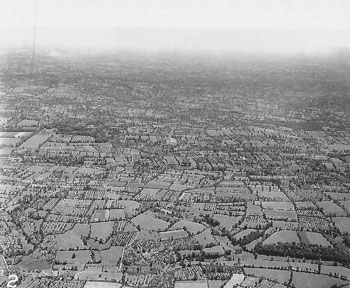 |
The tanks are no better off. They have two choices. They can go down the roads, which in this case were just mud lanes, often too narrow for a tank, often sunk four to six feet below the adjacent banks, and generally deep in mud. The Class 4 roads were decent in spots, but only for one-way traffic, with few exits to the adjacent fields. An armored outfit, whether it is a platoon or an armored army, attacking along a single road attacks on a front of one tank. The rest of the tanks are just roadblocks trailing along behind. When the first tank runs into a mine or an 88 or 75 shell, it always stops, and it usually burns up. And it efficiently blocks the road so the majestic column of roaring tanks comes to an ignominious stop.
The next step is to try to find out where the enemy gun or tank is, and wheel up a tank or so to shoot at him. The only trouble is, that probably only the men in the first tank saw his gun flash, and they aren't talking any more.
|
|
The tanks trying to get into position to do some shooting are easily seen and get shot before they can do much about it. I have seen it happen. In the hedgerows it is almost impossible to get firing positions in the front row, and in the rear you can't see the enemy anyway so no one bothers. Usually the tanks waited for the infantry to do something about it.
Instead of charging valiantly down the road, the tanks may try to bull their way through the hedgerows. This is very slow and gives the enemy time to get his tanks or guns where they can do the most good. Then he just waits. And in the solution, there is always a minor and local problem to be solved, a problem that caused a certain amount of irritation, and that is, who is going over the hedgerow first, the infantry or the tank? It is surprising how self-effacing most men can be in such situations.
Anyone who actually fought in the hedgerows realizes that at best the going was necessarily slow, and that a skilful, defending force could cause great delay and heavy losses to an attacking force many times stronger. This, because the attacker can't use his firepower effectively and because he can't advance rapidly except on the road where he is quickly stopped at some convenient spot.
There were a number of other factors that contributed to the difficulties of fighting through the hedgerows. The area was merely a succession of small enclosed pastures with a few orchards, likewise enclosed by hedgerows. Seldom could one see clearly beyond the confine of the field. It was difficult to keep physical contact with adjacent squads, platoons, or larger units. It was difficult to determine exactly where one was. Unlike conditions in open country, flanks could not be protected by fields of fire. All these contributed to the difficulties of control and caused a feeling of isolation on the part of small units. All this meant that the front-line troops thought their neighbours were nowhere around. They could not see them, they were not in the adjacent field, therefore they were behind. Often this feeling of being out on a limb would cause the leading elements to halt and wait for the tank units to come up (and sometimes these were ahead).
German counterattacks in the hedgerows failed largely for the same reasons our own advance was slowed. Any attack quickly loses its momentum, and then because of our artillery and fighter-bombers the Germans would suffer disastrous loss. In fact we found that generally the best way to beat the Germans was to get them to counterattack- provided we had prepared to meet them.
|
| Fighting intensified again on 16 July with fresh attempts by the 29th Infantry Division to clear out Martinville and bring the American line up to the St. Lô – Bayeux highway and to take all the ground between that road and the St. Lô – Isigny road, clearing out the last remnants of the II. Fallschirm-Korps. By 19 July all German attempts to keep American forces out of St. Lô had failed and the Fallschirmjäger were withdrawn to the heights to the east of the city. |
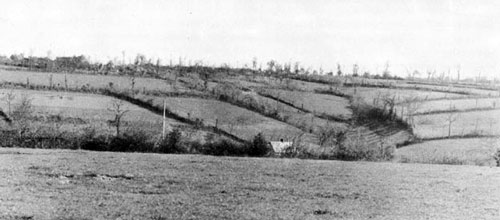 |
COBRA
When the Operation Cobra began on 25 July 1944 the main attacks, including the devastating carpet bombing, were all to the west of St. Lô. The next day, however, the Americans expanded their focus to include II. Fallschirm-Korps and the Jäger also came under heavy attack. US Forces penetrated the German main line of resistance in four places, with the most serious advance cutting between the II. Fallschirm-Korpsand the LXXXIV Korps, who were facing the main American thrust near St. Lô. This assault, depending on which direction the American attack was to take, had the potential of encircling and eliminating II. Fallschirm-Korps. |
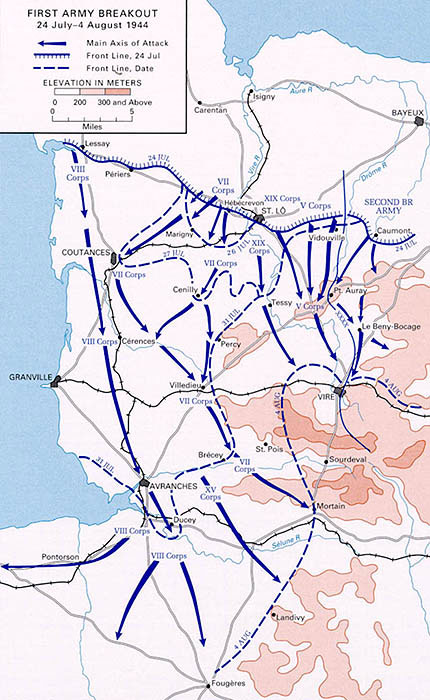 |
The 15. Fallschirmjägerregiment of 5. Fallschirmjägerdivision, the Parachute Corps only reserve, was quickly committed to the battle.
By the evening of 26 July 3. Fallschirm-
jägerdivision had managed to seal off all the penetrations, and despite some local withdrawals had maintained most of its front line. 12. Fallschirm Aufklärungs Abteilung was placed on the divisional flank and linked up with the 352. Infanteriedivision.
From 27 to 30 July numerous attacks by the Americans took place against the lines of the 3. Fallschirmjägerdivision that were all repelled. The attacks took on the appearance of simply attempting to pin II. Fallschirm-Korps in place. The II. Fallschirm-Korps did withdraw at little to straighten their front line and maintain contact with the German units on either flank.
On 31 July the much-anticipated attack by the British – Operation Bluecoat – began and the Guards Armoured Division was able to affect a deep penetration that threatened the eastern flank of
II. Fallschirm-Korps. 9. Fallschirm-
jägerregiment and 12. Fallschirm Aufklärungs Abteilung were quickly moved to protect that flank. As Bluecoat was progressing, renewed pressure from the American V Corps so began to threaten the western flank of the parachute corps, so 3. Fallschirmjägerdivision were again withdrawn to the new line of resistance. This withdrawal was so cleverly conducted using deception and local counterattacks, that the Jäger managed to conceal their intentions to the enemy, who was even forced to withdraw on occasions.
By 1 August the situation of the II. Fallschirm-Korps was again made untenable as the divisions on its flanks continued to fall back.
|
|
The parachute corps, now consisting of only the 3. Fallschirmjägerdivision , 15. Fallschirmjägerregiment (of 5. Fallschirmjägerdivision) and 12. Fallschirm Aufklärungs Abteilung slowly fell back in the centre while the two wings of the Corps surprised the pursuing Americans with well-delivered counterattacks, causing them to retreat. 3. Fallschirmjägerdivision now moved to the southern side of the Vire River, leaving strong combat outposts on the northern bank. These outposts included II. Fallschirm-Korps 8.8cm Flak batteries, which on 2 August forced British VIII Corps tanks advancing towards the river to retreat.
Over the next 5 days II. Fallschirm-Korps fought along the Vire River and the town of the same name, linking up with II SS Panzer Korps, 10. SS Panzer Division (Frundsberg) near Courte. The link up, effected by 8. Fallschirmjägerregiment trapped a number of British units behind German lines and 9. SS Panzer Division (Hohenstaufen) and 5. Fallschirmjägerregiment destroyed these units while capturing Burcy, Fergues and Presles. 9. and 15. Fallschirmjägerregiment and 12. Fallschirm Aufklärungs Abteilung continued to defend the river line and the town of Vire, inflicting heavy losses on the British.
|
FALAISE POCKET
10 August was a decisive day in the Normandy Campaign as the US Third Army suddenly turned to the north and northeast, which, in conjunction with the ongoing British offensive south of Caen revealed the Allies intention to trap the German armies in the region in a massive encirclement and destroy them. During the first six days of this new phase in the campaign the troops fighting on the II. Fallschirm-Korps front beat off two serious attacks, in one a battle knocking out 32 American tanks. Heavy artillery bombardments and fighter sweeps also continued to inflict casualties on the
Fallschirmjäger.
By 16 August, despite having blunted every major attack against them the combat efficiency of 3. Fallschirmjägerdivision had declined to a critical level. The division was reorganised into two kampfgruppen, each made up of two regiments, which would relieve each other in rotation during the coming withdrawal. |
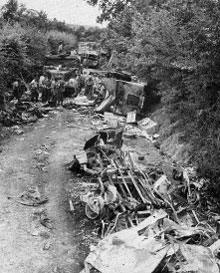 |
|
Early on 19 August 7. Armee was finally encircled by Allied forces. Trapped inside the pocket were two Army staffs (Seventh and Panzer Group Eberbach), four corps staffs, remnants of five Panzer Divisions (1. SS, 10. SS, 12. SS, 2. and 116.) along with nine infantry divisions (3. FJD, 84. ID, 89. ID, 271. ID, 276. ID, 277. ID, 326. ID, 353. ID and 363. ID).
Conditions in the pocket rapidly deteriorated. Innumerable vehicles were destroyed by artillery and aircraft, the German troops had few heavy weapons and little ammunition. Wounded men lay untended and the dead unburied in scenes rarely witnessed throughout the whole war.
Under these trying circumstances 7. Armee ordered II. Fallschirm-Korps to break out of the pocket near Trun and attack to the east of St. Lambert. The Jäger were to breakthrough the encirclement in a wedge formation, without firing their weapons if possible. 3. Fallschirmjägerdivision formed two wedges with 5. Fallschirmjägerregiment on the right, 9. and 15. Fallschirmjägerregiment on the left and 8. Fallschirmjägerregiment acting as rearguard. The Commander-in-Chief of Seventh Army and his staff attached themselves to 3. Fallschirmjägerdivision for the breakout.
II. Fallschirm-Korps began their attempt to break out at 2230 hrs on 19 August. The commander of 3. Fallschirmjägerdivision, Generalleutnant Schimpf was wounded immediately after the attack began, so the Corps commander General der Flieger Meindl assumed command of the division personally. The small assault groups quietly slip past the tanks of the 1st Polish Armoured Division and reached the Dives without any major incidents.
|
|
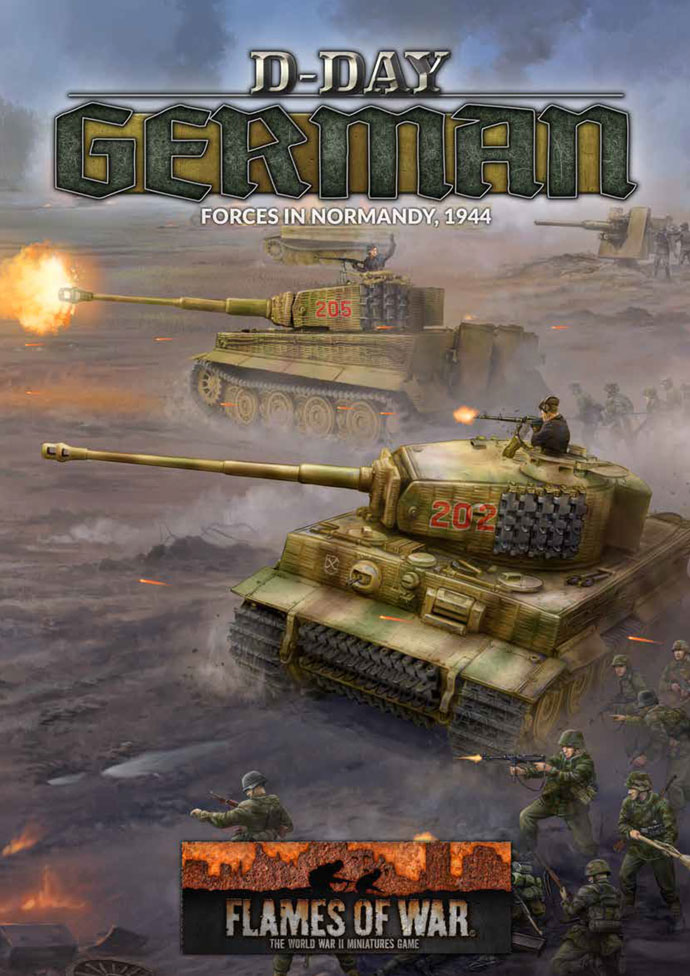
|
Here, they were held up for some time as they could see the eastern bank of the river was blocked by numerous enemy tanks between St Lambert and Magny. After careful reconnaissance, under the remaining darkness of the night small groups of the Jäger managed to worked their way through the lines of enemy tanks and strongpoints, and slipped out of the pocket, reaching the forward elements of the II SS-Panzer Korps.
Despite suffering tremendous casualties in the Normandy Campaign the 3. Fallschirmjägerdivision had fought from the first week of the invasion, through to its bitter end and had escaped, as greatly reduced but largely still cohesive unit. The Jäger would be back to fight another day.
6. Fallschirmjägerregiment in Normandy...
To Field 3. Fallschirmjäger Division in Flames Of War see D-Day: German.
|
Last Updated On Wednesday, October 16, 2019 by Wayne at Battlefront
|
|
|